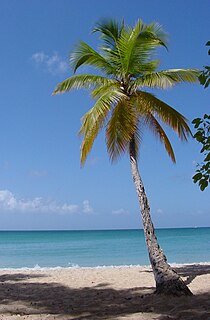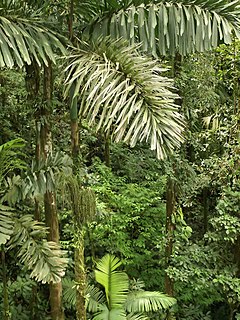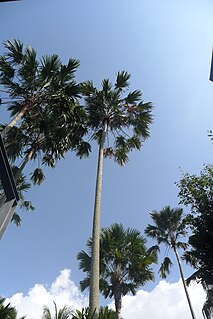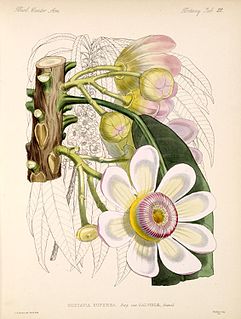
The Arecaceae is a family of perennial flowering plants in the monocot order Arecales. Their growth form can be climbers, shrubs, tree-like and stemless plants, all commonly known as palms. Those having a tree-like form are called palm trees. Currently, 181 genera with around 2,600 species are known, most of which are restricted to tropical and subtropical climates. Most palms are distinguished by their large, compound, evergreen leaves, known as fronds, arranged at the top of an unbranched stem. However, palms exhibit an enormous diversity in physical characteristics and inhabit nearly every type of habitat within their range, from rainforests to deserts.

Howea is a genus of two palms, H. belmoreana and H. forsteriana, both endemic to Lord Howe Island, Australia. H. forsteriana in particular is commonly grown as an indoor plant in the Northern Hemisphere, and the two species form the mainstay of the island's palm seed industry and more importantly its trade in newly germinated seedlings. The palms are also cultivated on Norfolk Island, where seeds are produced for export.

Conocarpus erectus, commonly called buttonwood or button mangrove, is a mangrove shrub in the family Combretaceae. This species grows on shorelines in tropical and subtropical regions around the world.

Bactris gasipaes is a species of palm native to the tropical forests of Central and South America. It is well spread in these regions, where it is often cultivated by smallholders in agroforestry systems or more rarely, in monoculture. Common names include peach palm in English, among others used in South American countries. It is a long-lived perennial plant that is productive for 50 to 75 years on average. Its population has an important genetic diversity, leading to numerous fruits, colors, and qualities. The fruits are edible and nutritious but need to be cooked for 30 minutes to five hours. They also benefit many animals in the wild. Peach-palms are also cultivated for the heart of palm, and the trunk can make valuable timber.

Socratea exorrhiza, the walking palm or cashapona, is a palm native to rainforests in tropical Central and South America. It can grow to 25 metres in height, with a stem diameter of up to 16 cm, but is more typically 15–20 m tall and 12 cm in diameter. It has unusual stilt roots, the function of which has been debated. Many species of epiphyte have been found growing on the palms. The palm is pollinated by beetles, and various organisms eat its seeds or seedlings.

Saribus rotundifolius, also known as the footstool palm, is a common fan palm found in Southeast Asia. It is a member of the genus Saribus.

Maytenus boaria (mayten) is an evergreen tree of the family Celastraceae, native from South America, up to 20 m (66 ft), 80 cm (31 in) diameter, straight trunk. It occurs naturally approximately from 30 to 50ºS: Chile.
Gustavia fosteri, one of several plants in the genus Gustavia known by the Spanish common name membrillo, is a species of woody plant in the family Lecythidaceae. It is found only on Barro Colorado Island in Panama. It is threatened by habitat loss.

Astrocaryum alatum is a species of palm with edible nuts, a flowering plant in the family Arecaceae. It is a common species found many types of rainforests and swamps in Honduras, Costa Rica, Nicaragua and Panama.

Phytelephas seemannii, commonly called Panama ivory palm, is a species of flowering plant in the family Arecaceae. It is one of the plants used for vegetable ivory.

Roscheria is an endangered, monotypic genus of flowering plant in the palm family. The genus is named for Albrecht Roscher, a 19th-century German explorer, and the epithet for its single species R. melanochaetes derives from Latin and Greek meaning 'black' and 'bristle', alluding to the spines covering the trunks. They naturally occur on the Mahé and Silhouette Islands of Seychelles where they grow in mountainous rainforest and are threatened by habitat loss.

Gustavia is a genus of flowering plants in the family Lecythidaceae described by Linnaeus in 1775. It is native to tropical Central America and South America. Many of the species are threatened; some are critically endangered Gustavia superba, though, is actually abundant in re-growing secondary forests. It grows in northern South America, from Panama south through the Andes as far as Ecuador, and along the Caribbean coast and in the Amazon basin. Gustavia flowers have numerous stamens, in some species as many as 1,200 in a single flower.

In botany, a tree is a perennial plant with an elongated stem, or trunk, usually supporting branches and leaves. In some usages, the definition of a tree may be narrower, including only woody plants with secondary growth, plants that are usable as lumber or plants above a specified height. In wider definitions, the taller palms, tree ferns, bananas, and bamboos are also trees. Trees are not a taxonomic group but include a variety of plant species that have independently evolved a trunk and branches as a way to tower above other plants to compete for sunlight. The majority of tree species are angiosperms or hardwoods; of the rest, many are gymnosperms or softwoods. Trees tend to be long-lived, some reaching several thousand years old. Trees have been in existence for 370 million years. It is estimated that there are some three trillion mature trees in the world.

Roystonea regia, commonly known as the Cuban royal palm or Florida royal palm, is a species of palm that is native to Mexico, parts of Central America and the Caribbean, and southern Florida. A large and attractive palm, it has been planted throughout the tropics and subtropics as an ornamental tree. Although it is sometimes called R. elata, the conserved name R. regia is now the correct name for the species. The royal palm reaches heights from 50 to over 80 feet tall. Populations in Cuba and Florida were long seen as separate species, but are now considered a single species.

Simarouba amara is a species of tree in the family Simaroubaceae, found in the rainforests and savannahs of South and Central America and the Caribbean. It was first described by Aubl. in French Guiana in 1775 and is one of six species of Simarouba. The tree is evergreen, but produces a new set of leaves once a year. It requires relatively high levels of light to grow and grows rapidly in these conditions, but lives for a relatively short time. In Panama, it flowers during the dry season in February and March, whereas in Costa Rica, where there is no dry season it flowers later, between March and July. As the species is dioecious, the trees are either male or female and only produce male or female flowers. The small yellow flowers are thought to be pollinated by insects, the resulting fruits are dispersed by animals including monkeys, birds and fruit-eating bats and the seeds are also dispersed by leaf cutter ants.

Platypodium elegans, the graceful platypodium, is a large leguminous tree found in the Neotropics that forms part of the forest canopy. It was first described by Julius Rudolph Theodor Vogel in 1837 and is the type species of the genus. The tree has been known to grow up to 30 metres in height and have a trunk with a diameter up to 1 m at breast height. Its trunk has large holes in it, sometimes making it possible to see through the trunk. The holes provide a habitat for giant damselflies and other insects both when alive and once the tree has died and fallen over. It has compound leaves each of which is made up of 10–20 leaflets. Three new chemical compounds have been isolated from the leaves and they form part of the diet of several monkeys and the squirrel Sciurus ingrami. In Panama it flowers from April to June, the flowers contain only four ovules, but normally only one of these reaches maturity forming a winged seed pod around 10 cm long and weighing 2 g. During the dry season around a year after the flowers are fertilised, the seeds are dispersed by the wind and the tree loses it leaves. The seeds are eaten by agoutis and by bruchid beetle larvae. The majority of seedlings are killed by damping off fungi in the first few months of growth, with seedlings that grow nearer the parent trees being more likely to die. The seedlings are relatively unable to survive in deep shade compared to other species in the same habitat. Various epiphytes are known to grow on P. elegans with the cactus Epiphyllum phyllanthus being the most abundant in Panama. Despite having holes in its trunk which should encourage debris and seeds to collect, hemiepiphytes are relatively uncommon, meaning that animals are not attracted to it to feed and then defecate. It has no known uses in traditional medicine and although it can be used for timber, the wood is of poor quality.
Ficus yoponensis is a species of fig tree found in Central and South America. It can grow to heights of 40–50 metres (130–160 ft) tall, having a trunk diameter of 1 metre (3.3 ft). The trunk is buttressed, light grey in colour and reasonably smooth. Its petioles are 1–2.5 centimetres (0.39–0.98 in) long, the stipules are straight and 3–5 centimetres (1.2–2.0 in) long. The leaves and stems are hairless. The leaves are 6–11 centimetres (2.4–4.3 in) long and 2.5–4 centimetres (0.98–1.57 in) wide, but larger in juveniles, being up to 28 centimetres (11 in) long and 5 centimetres (2.0 in) wide. The time at which they flower varies between individuals, but each tree tends to flower at a similar time each year. As in all figs, the flowers are enclosed inside the fig and can only be accessed by fig wasps, which enter to pollinate the flowers and lay their own eggs. The resulting fruit grows to 1.8 centimetres (0.71 in) in diameter and turns from green to purple with maturity. On average in Panama, F. yoponensis produce a new flush of leaves every 20 weeks and flower every 25 weeks. The species is similar in appearance to Ficus insipida but has smaller leaves, stipules and fruits and only occurs in primary forest whereas F. insipida is also found in secondary forest.

Ptychosperma elegans, commonly known as the solitaire palm, is a very slender palm endemic to Queensland in Australia. In the nursery trade and in the United States it may be confusingly referred to as Alexander palm, which is an often-used but misnomered name of another Australian palm species Archontophoenix alexandrae, the Alexandra palm.

Astrocaryum standleyanum is a species of palm known by many common names, including chumba wumba, black palm, chonta, chontadura, coquillo, palma negra, pejibaye de montaña, güerre, güérregue, güinul, mocora, pucaishchi (Chachi), and chunga (Emberá). It is native to Central and South America, where its distribution extends from Nicaragua to Ecuador. It is most common in central Panama, even becoming abundant in the tropical forests around the Panama Canal, but in general it is not a common plant.

In ecology, a light gap is a break in forest canopy or similar barrier that allows young plants to grow where they would be otherwise inhibited by the lack of light reaching the seedbed. Light gaps form predominantly when a tree falls, and thus produces an opening in the forest canopy. Light gaps are important for maintaining diversity in species-rich ecosystems.




















